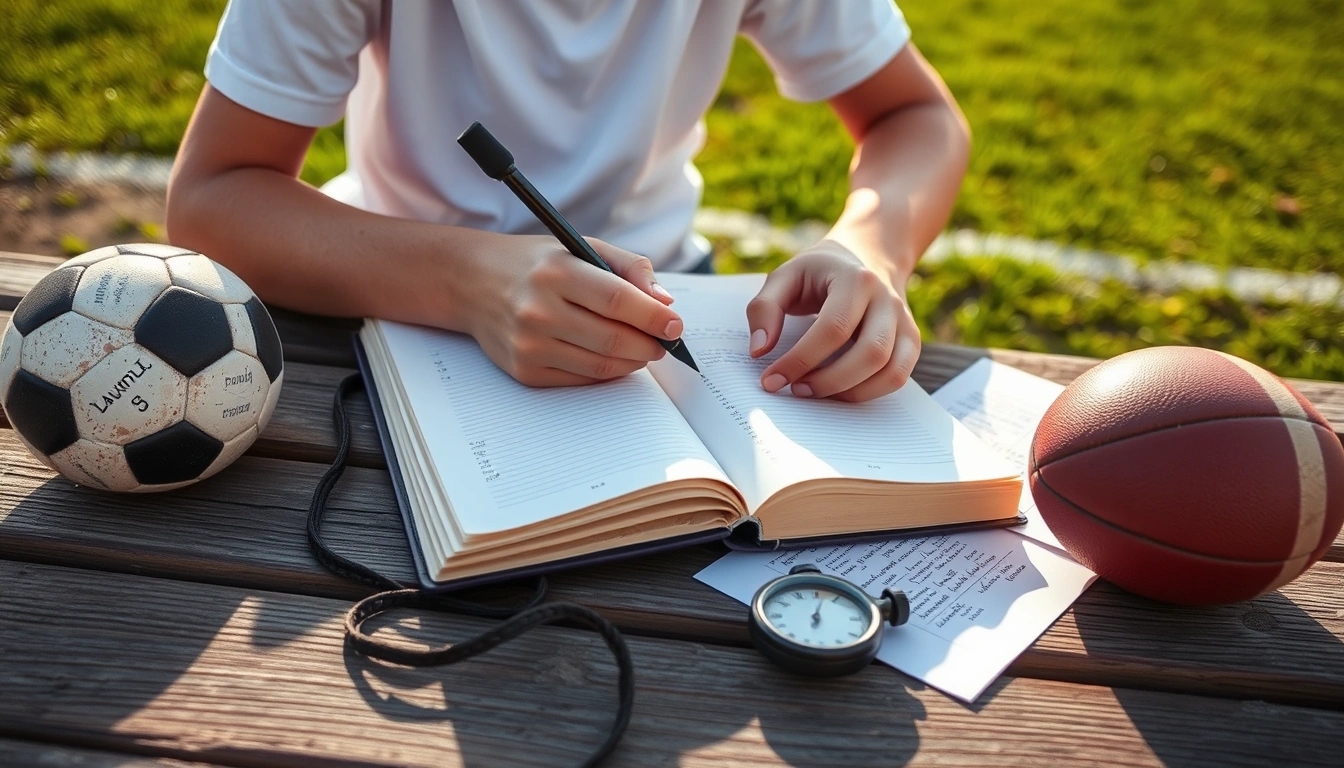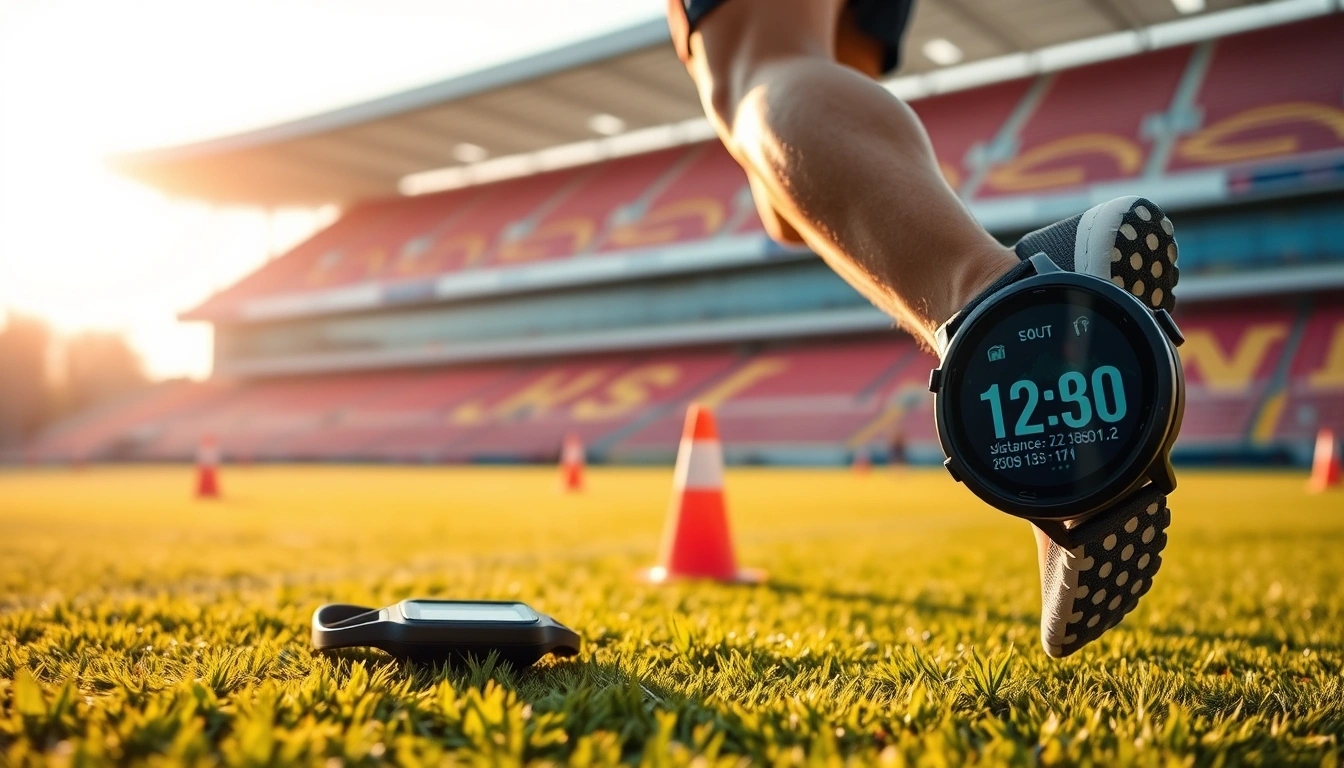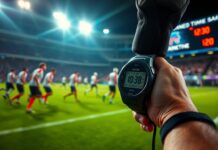Tracking your football journey? Oh, it’s way more than just tallying up goals and assists. Sure, those stats get the crowd roaring, but if you really wanna level up, you gotta dig deeper. It’s about spotting where you’re growing, where you’re stumbling, and yeah, celebrating those tiny wins that often get overlooked. Sounds simple, right? Well, not always. But stick with me, and I’ll break it down.
Setting Realistic Goals
Before you dive headfirst into tracking, you need a target. And no, “become Messi overnight” doesn’t count. Set goals that make sense for your current skill level. Maybe it’s improving your weak foot or nailing those corner kicks. Clear, achievable goals keep your motivation alive and kicking. Without them, you’re just wandering around the pitch, hoping for magic.
- Start small: e.g., “Complete 20 accurate passes in a game.”
- Make it measurable: “Increase sprint speed by 0.2 seconds.”
- Keep it realistic: Don’t aim to score 10 goals if you’re just starting out.
Using Performance Metrics
Stats can be your best friend or your worst nightmare. Ever seen those fancy charts with distance covered, pass accuracy, or successful tackles? Yeah, they look impressive but don’t get lost in numbers. Focus on metrics that actually tell you something useful.
| Metric | Why It Matters | How to Use It |
|---|---|---|
| Pass Accuracy | Shows how often you connect with teammates | Work on short and long passes to improve |
| Distance Covered | Reflects your stamina and work rate | Helps track fitness levels |
| Shots on Target | Measures shooting precision | Focus on shooting drills |
Keeping a Training Journal
Journaling? Yeah, it sounds old-school, but trust me, it’s gold. Writing down what you did, how you felt, and even the weather can reveal patterns you’d never notice otherwise. Plus, on those days when motivation’s MIA, flipping through past entries can remind you of how far you’ve come.
What to Include in Your Journal
- Drills and exercises completed
- Your mood and energy levels
- Any injuries or discomfort
- Weather conditions during training
Reviewing Your Journal Regularly
Don’t just write and forget. Set a weekly or biweekly reminder to go back and see what’s working and what’s not. You might spot a pattern like “always tired on rainy days” or “shooting accuracy improves after rest days.” This kind of insight is pure gold.
Video Analysis: Your New Best Friend
Watching yourself play? Yeah, it can be brutal. You’ll cringe, you’ll spot mistakes you never realized, but that’s the point. Record your matches and training sessions. It’s like having a replay button on your mistakes and successes.
Tools for Easy Video Analysis
- Your smartphone – seriously, just start there.
- Free apps like Hudl or Coach’s Eye for slow-motion and annotations.
- Simple editing tools to clip highlights.
What to Look For in Videos
Focus on the little things: positioning, decision-making, body language. Sometimes it’s not the flashy moves but the subtle stuff that makes or breaks a game.
Feedback from Coaches and Peers
You can’t see everything yourself. Getting feedback is crucial, even if it stings. Learn to take criticism without feeling crushed. Ask specific questions like “How was my positioning?” or “Did I communicate enough?” Use feedback as fuel, not a setback.
Tracking Physical Fitness
Football’s not just skill; it’s stamina, strength, and speed too. Keep tabs on your fitness with simple tests like timed sprints, endurance runs, or strength exercises. This way, you’ll know if you’re ready to keep up or if you need to hit the gym harder.
Balancing Mental and Emotional Progress
Last but definitely not least, don’t forget your head game. Confidence, focus, and mental toughness are just as important as physical stats. Try journaling your mindset or using apps that help with meditation and visualization. Tracking these can be tricky but totally worth it.
So yeah, tracking your progress isn’t just about the flashy numbers. It’s a messy, sometimes frustrating, but always rewarding process that helps you grow as a player and person. Now, get out there and start tracking like a pro!
Setting Realistic Goals
Alright, before you even think about tracking your progress as a young footballer, you’ve got to figure out where the heck you want to go with all this. It’s like trying to drive somewhere without a map—sure, you might get somewhere, but is it where you wanted? Setting goals isn’t just some boring checklist; it’s the fuel that keeps your fire burning when the training gets tough and the grass stains pile up.
Now, here’s the kicker: these goals have to be realistic. Don’t dream about scoring a hat-trick in the Premier League next weekend if you’re still struggling to nail a clean pass in training. It’s about breaking down the big dreams into bite-sized, chewable chunks. Think of it like leveling up in a video game—each small win gets you closer to the boss fight.
- Short-term goals: What do you wanna improve this week? Maybe it’s your weak foot control or your sprint speed.
- Medium-term goals: Stuff to work on over a few months, like boosting your stamina or mastering a new trick.
- Long-term goals: The big picture stuff, like making the school team or even dreaming about pro trials.
Here’s a little table to help you sort your goals out:
| Goal Type | Example | Why It Matters |
|---|---|---|
| Short-term | Improve passing accuracy by 10% this week | Builds confidence and sharpens skills fast |
| Medium-term | Run 3 km under 15 minutes in 3 months | Boosts endurance for full matches |
| Long-term | Make the varsity football team next season | Gives you a big target to chase and stay motivated |
But hey, don’t get too caught up in the numbers or the “perfect” goal-setting formula. It’s okay if your goals shift or if you miss a target—that’s part of the game. The key is to keep them flexible and personal. What works for your mate might not work for you, and that’s totally fine.
Also, keep your goals visible. Write them down somewhere you’ll see them every day—on your locker, your phone notes, or even your bathroom mirror. That little reminder can be the nudge you need when you’re tempted to skip training or slack off.
- Pro tip: Share your goals with a coach or a teammate. It’s like having a mini accountability buddy who’ll call you out if you’re slacking.
- Watch out: Avoid setting goals that are too vague like “get better” or “train harder.” Be specific or you’ll just end up spinning your wheels.
In the end, setting realistic goals isn’t about being perfect or having everything figured out from day one. It’s about carving out a path that feels doable and exciting, so you don’t lose steam halfway through the season. So grab a pen, jot down what you want, and get ready to chase it—one step, one game, one goal at a time.
Using Performance Metrics
Alright, let’s get real about numbers in football. You hear all the time that “numbers don’t lie,” but honestly? Sometimes they do—or at least they can be super misleading if you don’t know what to look for. Tracking your progress as a young footballer isn’t just about tallying goals or counting how many passes you made. It’s way more nuanced than that. So, buckle up, because we’re diving into which stats actually matter and how to not get buried under a mountain of data.
First off, distance covered during a match is a popular stat. Coaches love it because it shows how much ground you’re covering. But here’s the catch: running a lot doesn’t automatically mean you’re playing well. You could be sprinting around like a headless chicken without making any smart plays. So, pairing distance covered with positional awareness is key. Are you running to support your teammates or just chasing shadows? That’s the real question.
| Performance Metric | What It Tells You | Common Misconceptions |
|---|---|---|
| Distance Covered | Measures stamina and work rate | More running better player (not always true) |
| Pass Accuracy | Shows precision and decision-making | High percentage means good passing (sometimes just safe passes) |
| Shots on Target | Indicates attacking threat | More shots effective striker (ignores shot quality) |
Now onto pass accuracy. This one’s tricky. A 90% pass accuracy sounds amazing, right? But if all your passes are sideways or backward, well, you’re not exactly setting the pitch on fire. The trick is to look at progressive passes—those that actually move the ball forward and create chances. So, don’t just obsess over percentages; think about the context.
- Key passes: Passes that lead to a shot on goal.
- Successful dribbles: Beating a defender to create space.
- Defensive actions: Tackles, interceptions, blocks—because defense wins games too.
Feeling overwhelmed yet? You’re not alone. The flood of stats can be dizzying, but here’s a handy tip: focus on two or three metrics at a time that align with your position and goals. For example, if you’re a winger, track crosses completed and dribbles rather than tackles.
Step-by-step to smart metric tracking:1. Identify your role on the pitch.2. Pick relevant stats (don’t try to track them all).3. Use apps or notebooks to record after each game/training.4. Analyze trends over weeks, not just one-off games.5. Adjust your training based on what the numbers tell you.
Remember, metrics are tools, not gospel. They should spark questions, not stress you out. If a stat looks off, ask why. Maybe you were playing injured, or the team tactics changed. Numbers don’t capture feelings, grit, or those moments when you just “feel” unstoppable.
So yeah, stats can help you improve—but only if you use them wisely. Otherwise, you might just end up chasing numbers instead of becoming a better player. And that, my friend, would be the biggest miss of all.

Keeping a Training Journal
Alright, let’s be honest — writing stuff down might sound like something your grandma would insist on, or maybe that dusty advice from a coach who swears by old-school methods. But trust me, keeping a training journal is pure gold for any young footballer serious about leveling up. It’s not just about scribbling dates and drills; it’s about catching those sneaky patterns, tracking your ups and downs, and spotting those frustrating plateaus that make you wanna throw in the towel sometimes.
Imagine this: you’re grinding week after week, but some days the ball just won’t stick, or your legs feel like jelly. Without a journal, you might miss the fact that every time you train after a late night, your performance dips. Writing it down makes these connections pop out like a flashing neon sign. Plus, when you’re stuck in a rut, flipping back through your notes can remind you of the progress you actually made — even if it feels like you’re moving backwards.
- What to jot down? Start simple: drills you did, how you felt physically and mentally, weather conditions, and any injuries or soreness. Don’t forget to note your mood — sometimes a bad day off the pitch affects your game more than you think.
- Be honest. If you had a rubbish session, say it. If you smashed a new personal best, celebrate it in your journal! This honesty helps you identify real trends.
| Journal Entry Element | Why It Matters |
|---|---|
| Drills & Exercises | Tracks what you’re working on and reveals what’s improving or needs more focus. |
| Physical Feelings (Tired, Energized, Sore) | Helps spot overtraining or recovery needs. |
| Mental State (Focused, Distracted, Confident) | Shows how mindset impacts performance. |
| Weather Conditions | Sometimes weather affects your play more than you realize. |
| Notes on Opponents or Coaches’ Feedback | Reminds you of external factors influencing your sessions. |
Now, here’s the kicker — the real magic happens when you review your journal regularly. It’s tempting to just write and forget, but going back through your notes every couple of weeks can be a game-changer. You might spot that your passing accuracy improves on sunny days or that your energy tanks after a certain type of drill. This insight lets you tweak your training smartly instead of just guessing.
Plus, it’s a serious confidence booster. When motivation’s running low and you’re questioning if all this effort is worth it, flipping through your journal and seeing clear progress — even small wins — can keep you pushing. It’s like having a personal cheerleader in your pocket.
Tips for Effective Training Journaling:- Keep entries short but consistent.- Use bullet points or quick phrases — no need for essays.- Include a “What I learned today” section.- Don’t stress about perfect grammar; it’s for YOU.- Use colors or symbols to highlight great days or tough ones.
In the end, a training journal isn’t just a notebook; it’s your secret weapon for self-awareness and growth. So grab a pen, a notebook, or even your phone’s notes app, and start writing. It might feel a bit old-fashioned, but hey — some classics never go out of style.
What to Include in Your Journal
Alright, so you’ve decided to keep a training journal. Good call! This isn’t just about scribbling down “ran 5k” or “did some drills.” Nah, it’s way more than that. Your journal is like a secret weapon, a treasure chest of insights that can totally change how you train and improve. But what exactly should you jot down? Let’s break it down, no fluff.
| Category | Details to Note | Why It Matters |
|---|---|---|
| Drills & Exercises | Type of drill, duration, intensity, focus area (e.g., shooting, dribbling, passing) | Tracks what skills you’re working on and how often. Helps spot if you’re neglecting any part of your game. |
| Feelings & Mood | Energy levels, motivation, frustration, confidence, any mental blocks | Understanding your mindset can explain good or bad days. Mental state affects performance more than you think. |
| Weather Conditions | Temperature, rain, wind, humidity | Surprisingly, weather can impact how well you perform or recover. Noting this helps connect external factors to your output. |
| Physical Condition | Any aches, injuries, fatigue, sleep quality | Prevents overtraining and injury by spotting warning signs early. |
| Performance Notes | What went well, what sucked, unexpected challenges | Reflecting on sessions helps you learn from mistakes and celebrate small wins. |
Now, you might be thinking, “Geez, that’s a lot to write down after every session.” And yeah, it can feel like a chore, but trust me, the payoff is worth it. Plus, you don’t have to get all Shakespearean about it. Bullet points, quick phrases, emojis — whatever works for you. The key is consistency.
- Tip 1: Use shorthand or abbreviations to speed things up.
- Tip 2: If you’re feeling lazy, just jot down one thing you did well and one thing to improve.
- Tip 3: Don’t skip the emotional stuff! Your mood influences your game more than you realize.
Here’s a quick example of a journal entry to get you started:
Date: 04/27/2024Drills: 30 min dribbling drills, 20 min passing exercisesFeelings: Felt pumped at first, got tired halfway, lost focus a bitWeather: Sunny, warm (75°F), light breezePhysical: Slight soreness in left calf, slept 7 hoursPerformance: Passing accuracy improved, need to work on stamina
See? Not rocket science. But over weeks and months, these notes start painting a clear picture of your progress. You’ll notice trends like, “Oh, I always struggle when it’s humid” or “My shooting improves after a good night’s sleep.” That’s gold.
So, don’t just think about goals and stats. Your journal captures the messy, human side of football training — the ups, the downs, the weird days when nothing clicks. Embrace it all, because that’s how you grow.
Remember: The best journal is the one you actually keep. So keep it real, keep it simple, and keep it coming. Your future self will thank you.
Reviewing Your Journal Regularly
Alright, let’s get real here. You might be jotting down your daily drills, feelings, and random thoughts about the weather (yes, that matters more than you think), but if you never actually go back and look at what you wrote, what’s the point? Checking back on your notes isn’t just some boring chore—it’s like having a personal highlight reel and a reality check all rolled into one. You get to see how far you’ve come, which can be a huge confidence booster, especially on those days when you feel like you’re stuck in quicksand.
Think of your journal as a map. If you never glance at it, you might keep wandering in circles. But when you take a moment to review, you spot the places where you struggled, the moments you nailed, and the patterns that pop up again and again. Maybe you notice that your passing accuracy dips on rainy days, or that your energy tanks after a certain drill. These little nuggets of info are pure gold because they tell you exactly where to focus your efforts next.
- Motivation Booster: Seeing progress written out, no matter how small, can light a fire under you when motivation is running low.
- Spot Weaknesses: You can’t fix what you don’t know is broken. Your journal reveals those hidden weak spots.
- Track Consistency: Are you training hard every day, or just when you feel like it? Your notes will tell the truth.
Now, don’t get me wrong—this isn’t about obsessing over every little detail or beating yourself up for a bad day. It’s about being honest and curious. If you notice you’re always tired on Thursdays, maybe you need to tweak your rest days or nutrition. If your mood is off during training, jot down what’s going on outside the pitch. Sometimes, the biggest game-changer isn’t a new drill but sorting out what’s happening in your head.
| Aspect | What to Look For | Why It Matters |
|---|---|---|
| Drills Completed | Frequency, variety, and difficulty | Tracks skill development and workout intensity |
| Performance Notes | Successes, mistakes, and feelings about drills | Highlights strengths and areas needing improvement |
| Physical Condition | Energy levels, soreness, injuries | Helps manage training load and recovery |
| Mental/Emotional State | Confidence, stress, motivation | Ensures mental readiness and resilience |
So, how often should you review your journal? Ideally, at least once a week. That way, you keep the info fresh and can adjust your training before bad habits sneak in. And if you’re feeling extra motivated, try monthly summaries. They’re like your personal report cards, but without the boring lectures from teachers.
Bottom line: don’t just write your journal and forget it in some dusty corner. Make it a living tool that helps you understand your journey better. Trust me, the little “aha” moments you get when rereading your notes can be way more motivating than you’d expect. It’s like having a conversation with your past self, cheering you on, and pointing out stuff you missed the first time around. And hey, who doesn’t want a coach in their pocket?
Video Analysis: Your New Best Friend
Alright, let’s get real for a second. Watching yourself play football is like watching a horror movie where you’re the star — brutal, cringe-worthy, but oddly necessary. You think you nailed that pass? Nope, the replay shows you fluffed it. Thought you were everywhere on the pitch? Well, turns out you took a nap for 10 seconds mid-game. But here’s the kicker: this painful self-examination is exactly what makes you better. No sugarcoating, no excuses.
Why bother recording your matches and training sessions? Because your brain can only hold so much info during the chaos of a game. When you watch the footage later, you catch all those tiny mistakes and hidden gems that flew under your radar. Maybe you didn’t realize you were drifting too far offside or that your body language screamed “I have no clue what I’m doing.” On the flip side, you’ll also spot moments where you shone — that slick dribble, the perfect tackle, or an unexpected assist. It’s like having a highlight reel and a critique session rolled into one.
- Spotting Mistakes: Ever wonder why your passes get intercepted? Video can show you if you’re telegraphing your moves or just plain sloppy.
- Recognizing Strengths: That burst of speed or clever positioning? You’ll see it, and you’ll want to do more of it.
- Tracking Progress: Comparing footage over weeks or months? You’ll actually see yourself improve — or realize you’ve been stuck in a rut.
Now, don’t freak out thinking you need expensive gear or a professional cameraman. Most smartphones today do a decent job recording matches and training drills. Even a simple tripod or a friend holding the phone works wonders. For those who want to get a bit fancy, there are apps designed to analyze your gameplay, highlight key moments, and even break down your stats.
| Tool | Cost | Main Feature | Best For |
|---|---|---|---|
| Smartphone Camera | Free (you already have one!) | Basic recording | Beginners & casual players |
| Coach’s Eye App | Low cost | Slow-motion & annotations | Detailed technique review |
| Hudl | Subscription-based | Video analysis + stats | Competitive players & teams |
When reviewing your videos, focus on three things: positioning, decision-making, and body language. Seriously, these little details can make or break your game. For instance, are you standing too flat-footed before a pass? Are you hesitating when you should be attacking? Is your head down way too much? The answers to these questions will jump off the screen.
One more thing — don’t just watch the clips once and say, “Yeah, I’m good.” Revisit them regularly, even if it’s painful. It’s like going to the gym for your brain and game sense. And hey, if you catch yourself making the same mistakes over and over, don’t despair. It means you’re aware, which is half the battle won.
In the end, video analysis isn’t about turning you into a robot player who never makes mistakes. It’s about embracing your flaws, celebrating your wins, and slowly but surely turning those “oops” moments into “heck yeah” moments. So grab that camera, start recording, and get ready to see yourself in a whole new light — awkward moments and all.
Tools for Easy Video Analysis
Alright, so you’ve decided to get serious about your game and video analysis is on your radar. But hold up—before you imagine some high-tech, rocket-science setup, let me tell ya, it doesn’t have to be that complicated or expensive. In fact, you can start right now with just your phone. Yep, that little device in your pocket is more powerful than you think.
Start Simple: Your Phone Camera
No fancy gear? No problem! Most smartphones nowadays shoot in HD or even 4K, which is more than enough to catch the action. Just prop it up somewhere stable—maybe a tripod or even a stack of books—and hit record during your training or match. The key here is consistency; try to film from similar angles each time so you can compare apples to apples.
- Pros: Super accessible, free, easy to use.
- Cons: Limited zoom, no slow-motion features unless your phone supports it.
Step Up: Budget-Friendly Apps
If you want to get a bit fancy without breaking the bank, there are loads of apps designed specifically for athletes and coaches. Apps like Hudl, Coach’s Eye, or Ubersense let you slow down footage, draw on the screen, and compare clips side-by-side. Some have free versions with basic features, so you can test-drive before committing any cash.
| App | Key Features | Cost |
|---|---|---|
| Hudl | Video playback, slow motion, telestration | Free with in-app purchases |
| Coach’s Eye | Slow motion, side-by-side comparison, annotations | Free trial, then approx. $5/month |
| Ubersense | Slow-motion, frame-by-frame analysis | Free basic version |
Don’t Overthink It
Look, it’s tempting to get lost in tech and forget why you’re doing this in the first place: to get better. So here’s a pro tip—focus on one or two things at a time when reviewing your videos. Maybe you want to check your positioning or how you handle the ball under pressure. Trying to analyze everything at once will just fry your brain and probably make you quit halfway through.
Quick checklist for your video sessions:- Set up your camera at the same spot each time- Record full drills or matches, not just highlights- Watch videos with a clear focus (e.g., passing accuracy)- Take notes or use app tools to mark key moments
Bonus: Share and Get Feedback
Don’t be shy—send clips to your coach or teammates. Sometimes, fresh eyes catch stuff you miss. Plus, it’s a great way to stay connected and motivated.
In a nutshell, video analysis doesn’t have to be rocket science or cost a fortune. Your phone, some free or cheap apps, and a bit of dedication can turn your game insights from “meh” to “heck yeah!” So, grab that phone, start recording, and watch yourself grow—one frame at a time.
What to Look For in Videos
Alright, so you’ve got your camera rolling, and you’re ready to dive into the world of video analysis. But hold up — what exactly should you be hunting for? It’s not just about spotting that one killer goal or the moment you tripped over your own feet (we’ve all been there). The magic lies in the details, the subtle stuff that can totally change your game without you even realizing it. Positioning, decision-making, and body language are your golden trio here. Sounds fancy? Nah, it’s just football smarts wrapped in everyday moves.
- Positioning: Where are you on the pitch when the ball’s in play? Are you always in the right spot to receive a pass, or do you find yourself chasing shadows? Watch how you move relative to teammates and opponents. Good positioning means less running, smarter plays, and more chances to shine. Sometimes, just a tiny step to the left or right can open up a world of opportunities. Don’t just look at where the ball is — look at where you are when the ball isn’t there.
- Decision-Making: This one’s a doozy. Football isn’t just about fancy footwork; it’s about making the right call in split seconds. Are you passing when you should shoot? Holding the ball too long? Sometimes you’ll see yourself freeze or panic — hey, it happens. The trick is spotting those moments and figuring out how to react better next time. Video shows you your brain’s playbook in action (or inaction).
- Body Language: Believe it or not, how you carry yourself speaks volumes. Are you confident or hesitant? Do you slump when tired or keep your head up? Your body language can influence teammates and even intimidate opponents. Plus, it’s a key indicator of your mental state during the game — and mental toughness is half the battle.
| Aspect | What to Look For | Why It Matters |
|---|---|---|
| Positioning | Spacing, movement off the ball, awareness of teammates and opponents | Improves efficiency, creates opportunities, reduces unnecessary effort |
| Decision-Making | Timing of passes/shots, choices under pressure, risk vs reward | Leads to better plays and fewer turnovers |
| Body Language | Posture, eye contact, energy levels | Reflects confidence and influences team dynamics |
Now, don’t get me wrong — watching yourself on video can be brutal. You’ll cringe at that missed tackle or that awkward stumble. But here’s the kicker: those tiny mistakes? They’re your best teachers. The key is to keep your eyes peeled for patterns. Maybe you always hesitate before passing when under pressure, or you tend to drift too far forward, leaving your defense exposed. Catching these habits early means you can fix ‘em before they become “classic blunders.”
- Watch clips in slow motion to catch small movements you’d miss at full speed.
- Focus on just one aspect per viewing — maybe today it’s all about your positioning, tomorrow it’s decision-making.
- Take notes or jot down timestamps of key moments to revisit later.
- Don’t just watch your mistakes — highlight your good plays too. Confidence booster, anyone?
Remember, the devil’s in the details. Sometimes, it’s the tiniest shift in your stance or a quicker glance at a teammate that turns a “meh” game into a match-winning performance. So, grab that phone, hit record, and start seeing yourself through a sharper lens. Trust me, the difference it makes? Huge.
Keep grinding, and keep those eyes open!
Feedback from Coaches and Peers
Alright, listen up — nobody likes being told they messed up, right? But if you wanna get better at football, you *have* to get comfortable with criticism. It’s like eating your veggies: not always tasty, but essential for growth. Sometimes, you’re so deep in your own head, thinking you’re the next Messi, that you miss the obvious stuff. That’s where an outsider’s perspective comes in handy — be it your coach, teammates, or even a random friend who knows a thing or two about the game.
Now, here’s the catch: taking feedback without feeling like you just got kicked in the ego is tough. You might hear things like, “You’re slow on your first touch,” or “Your positioning needs work.” Ouch. But guess what? That’s not a personal attack — it’s a golden ticket to improving. Instead of shutting down or getting defensive (we’ve all been there), try to listen actively. Ask questions if you’re confused. Jot down notes. Treat it like a game plan for your next training session.
| Common Feedback Types | How to Use It |
|---|---|
| Technical advice (passing, shooting, dribbling) | Practice specific drills targeting these skills. Video yourself to track progress. |
| Tactical awareness (positioning, decision-making) | Watch game footage, discuss scenarios with coaches, and simulate situations in training. |
| Physical fitness (speed, stamina) | Incorporate fitness routines and monitor improvements with apps or journals. |
| Mental and emotional feedback (confidence, focus) | Reflect on mindset, try visualization techniques, and maybe chat with a mentor or sports psychologist. |
Look, feedback isn’t a one-way street either. Coaches and peers appreciate when you show you’re open to learning — it builds trust and sometimes even earns you more personalized advice. But be real with yourself, too. Not all feedback is created equal. Some might be vague (“You need to try harder”) or just plain unhelpful (“You’re terrible today”). Learn to filter out the noise and focus on the stuff that actually helps you grow.
- Tip 1: Don’t take criticism personally. It’s about your performance, not your worth.
- Tip 2: Ask for examples — specifics beat general comments every time.
- Tip 3: Set small goals based on feedback to avoid feeling overwhelmed.
- Tip 4: Remember to celebrate improvements, no matter how tiny.
Here’s a little secret: sometimes, the hardest feedback to swallow is the most valuable. When your coach points out a flaw you never noticed, or a teammate gently calls you out on something, that’s pure gold. It means they care enough to help you get better. So next time you get that critique, take a deep breath, nod like you totally get it (even if you don’t), and then get back out there ready to crush it.
In the end, feedback is less about finding flaws and more about uncovering potential. Embrace it, use it, and watch your game transform. Because let’s be honest — no one ever became a pro by thinking they were perfect.

Tracking Physical Fitness
Football isn’t just about fancy footwork or scoring that killer goal; it’s a brutal mix of stamina, strength, and speed. You could be the slickest dribbler on the pitch, but if your legs give out halfway through the match, well, good luck finishing strong. So, how do you keep tabs on your fitness levels without turning into a science experiment? Let’s break it down—no sweat.
- Stamina: This is your engine. Without endurance, you’ll be gasping for air like a fish out of water by the second half. Tracking your stamina means measuring how long you can sustain effort. Think timed runs, shuttle sprints, or even just how many laps you can do without collapsing. Apps and smartwatches can help here, but even a stopwatch and some honest self-assessment work wonders.
- Strength: Football demands explosive power—whether it’s winning a tackle or blasting a shot. Strength tracking involves monitoring your progress in weight training or bodyweight exercises. Keep a log of reps, sets, and weights lifted. Seeing those numbers climb is a real mood booster, trust me.
- Speed: Blink and you’ll miss it. Sprinting speed is crucial for breaking defenses or catching a loose ball. Measure your 20m or 40m dash times regularly. A stopwatch, a friend, and a flat stretch of grass are all you need.
| Fitness Component | How to Track | Why It Matters |
|---|---|---|
| Stamina | Timed runs, shuttle sprints, heart rate monitoring | Ensures you can maintain performance throughout the match |
| Strength | Weight training logs, bodyweight exercise tracking | Improves power for tackles, shots, and physical duels |
| Speed | Timed sprints (20m, 40m), reaction drills | Helps in outrunning opponents and quick transitions |
Now, you might be thinking, “Okay, but how often do I have to do all this?” Honestly? Consistency beats intensity. Tracking your fitness once a week is a solid start. Don’t freak out if you hit a plateau or even regress a bit—fitness isn’t a straight line, more like a rollercoaster with some unexpected drops. The key is to keep at it and adjust your training based on what the data tells you. If your sprint times are slipping, maybe you need more rest or different drills. If your stamina tanks, maybe it’s time to swap Netflix for some extra cardio.
Also, don’t forget recovery. Tracking how well you bounce back after training or matches—think sleep quality, muscle soreness, and energy levels—is just as important as tracking your workout stats. Your body’s not a machine, no matter how much you wish it were.
Practical tips for tracking fitness:- Use a simple notebook or an app to jot down times, reps, and how you feel.- Set mini-challenges, like shaving a second off your sprint or adding 5 more push-ups.- Mix up your workouts to avoid boredom and plateaus.- Ask a coach or buddy to help keep you honest and motivated.
At the end of the day, tracking your physical fitness isn’t about obsessing over every detail. It’s about staying aware, making smarter training choices, and showing up ready to give your best on the pitch. So, lace up, track smart, and let your fitness do the talking when it’s game time.
Balancing Mental and Emotional Progress
Alright, listen up! Tracking your physical stats like goals scored or distance run is cool and all, but if your mind isn’t in the game, you’re just spinning your wheels. Football isn’t just about muscles and cardio; it’s a full-on mental battle. So, how do you keep tabs on your confidence, focus, and mental toughness? Glad you asked. It’s not as straightforward as counting goals, but it’s just as important.
First off, confidence is a slippery little devil. Some days you feel like Messi, other days more like a benchwarmer. One way to track it? Keep a simple mental check-in log. After every training or match, jot down how you felt. Were you pumped or dragging? Did you doubt yourself? Over time, patterns will pop up. Maybe you’re less confident against tougher teams or when playing away. Knowing this is half the battle.
- Example Mental Check-in:
- Confidence level (1-10)
- Focus rating (1-10)
- Emotional state (nervous, excited, frustrated)
- Notes on what triggered these feelings
Next, focus. It’s easy to say “stay focused,” but staying laser-sharp for 90 minutes? That’s a whole different story. Try breaking your game down into chunks. Did you zone out during the first half? Or maybe you lost concentration in the last 10 minutes. Use a simple table like this to keep track:
| Game Segment | Focus Level (1-10) | Notes |
|---|---|---|
| First 30 mins | 7 | Good, but got distracted after a bad pass |
| Next 30 mins | 5 | Lost focus, tired legs |
| Last 30 mins | 6 | Regained focus after coach’s shout |
Now, mental toughness — the secret sauce. This one’s tricky because it’s about how you bounce back from setbacks. Missed a penalty? Got yelled at by your coach? Mental toughness is how fast you shake it off and get back in the zone. You can’t exactly measure this like speed or distance, but you can note your reactions. Do you sulk or do you get fired up? Write it down.
Here’s a quick checklist to help you track mental toughness:
- How quickly do you recover from mistakes?
- Do you stay positive during tough moments?
- Can you keep calm under pressure?
- Are you motivated to improve after criticism?
Don’t forget, emotional ups and downs are normal. It’s okay to feel frustrated or anxious. The key is recognizing those emotions and learning how to manage them rather than letting them control you. Sometimes, just talking to a teammate or coach about how you feel can be a game-changer.
So yeah, tracking mental and emotional progress isn’t as neat as tracking goals or assists, but it’s just as crucial. Your brain and heart have to be in sync with your body if you want to really level up. Keep a journal, use simple rating systems, and don’t be scared to admit when things aren’t perfect. Because guess what? No one’s perfect, and that’s what makes this journey worth it.
Remember: Your mind’s gotta be in the game too — don’t leave it on the bench.
Frequently Asked Questions (The title must be written in English.)
- Why is setting realistic goals important for young footballers?
Setting realistic goals acts like your personal GPS on the football journey. It keeps you focused, motivated, and prevents burnout. When goals are clear and achievable, you can celebrate each milestone, which fuels your passion and pushes you to improve consistently.
- Which performance metrics should I focus on to track my progress?
Not all stats are created equal! Concentrate on key metrics like distance covered, pass accuracy, and successful tackles. These numbers give you a solid snapshot of your effectiveness on the pitch without drowning you in data overload.
- How can keeping a training journal boost my development?
Think of a training journal as your personal football diary. Jotting down drills, feelings, and even weather conditions helps you spot patterns and plateaus. Reviewing it regularly reveals your growth and highlights areas needing extra attention.
- What’s the best way to use video analysis to improve my game?
Recording your matches and training sessions is like holding up a mirror to your performance. Focus on your positioning, decision-making, and body language. These subtle details often hold the key to unlocking your next level.
- How do I handle feedback from coaches and teammates without feeling discouraged?
Feedback is your secret weapon, not a setback. Embrace criticism as a tool for growth, not a personal attack. Ask questions, reflect, and use it to fine-tune your skills and mindset.
- Why is tracking physical fitness as important as technical skills?
Football isn’t just about fancy footwork; stamina, strength, and speed keep you in the game longer and help you outpace opponents. Monitoring fitness ensures you’re always ready to give 100% on the pitch.
- How can I measure and improve my mental and emotional progress?
Mental toughness is the invisible edge. Track your confidence, focus, and stress levels regularly. Techniques like mindfulness and visualization can boost your mental game, making you as resilient as you are skilled.













